Using a water softener for the first time? Or just looking to program a specific setting in your water softener, and need a refresher?
Here, we’ve covered the step-by-step process of programming a water softener from start to finish. Read on if you need to know the entire process, or browse the contents below if you need to program just one setting.
Table of Contents
- 👨🏼🔧 Why Program a Water Softener?
- ▶️ Step 1: Set Up the Softener
- ▶️ Step 2: Switch the Softener On
- ▶️ Step 3: Set the Clock Settings
- ▶️ Step 4: Set the Hardness Setting
- ▶️ Step 5: Set the Salt Dosage Setting (If Applicable)
- ▶️ Step 6: Set the Regeneration Setting
- 📖 How to Program a Softening System With a Digital Control Head
- 📟 How to Program a Softening System With Bluetooth Control
- ⏱ How to Program a Softening System With Clock Control
- 🧠 How to Program a Water Softening System: FAQs
👨🏼🔧 Why Program a Water Softener?
When you buy a water softener, it’ll be delivered to your home either with no pre-set programming, or with generic programming that doesn’t suit your water softening needs.
It’s likely that your water softener’s pre-set programming won’t reflect your own programming requirements. For instance, the hardness setting could be too low, causing water softener to regenerate too infrequently to protect your home from hard water 24/7.
Programming a water softener gives you control over how effectively your softener performs, and other important factors, like the regeneration cycle frequency, time, and length.
Most water softener owners’ manuals come with instructions on how to program the system, but you can use the information below as a general guide.
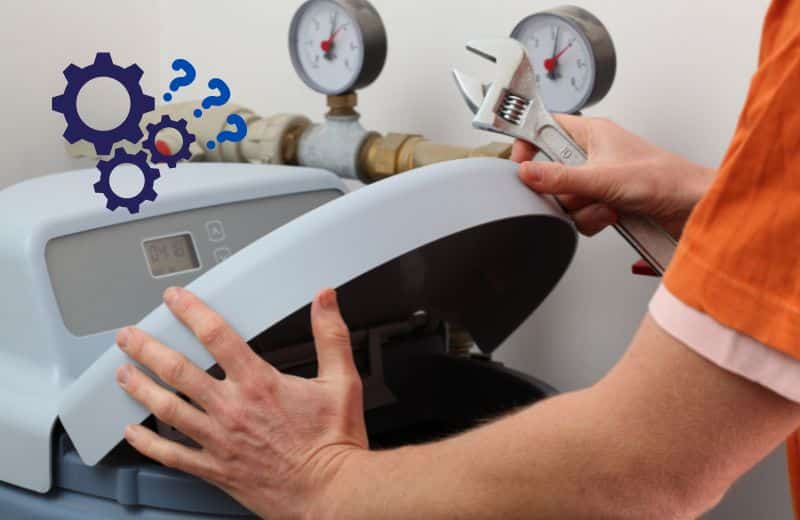
▶️ Step 1: Set Up the Softener
First, install your water softener and make sure the brine tank is clean and ready for use. The resin tank should be pre-loaded with resin.
Add water softener salt to the brine tank (here’s how), stopping at the max fill line.
▶️ Step 2: Switch the Softener On
Next, plug the water softener into a nearby power outlet (preferably on a GFCI outlet) and switch it on. Open the bypass valve to allow water to pass through the softener.
If you notice any leaks, shut off the water and tighten your fittings, then switch the water back on. You’re now ready to program the water softener settings.
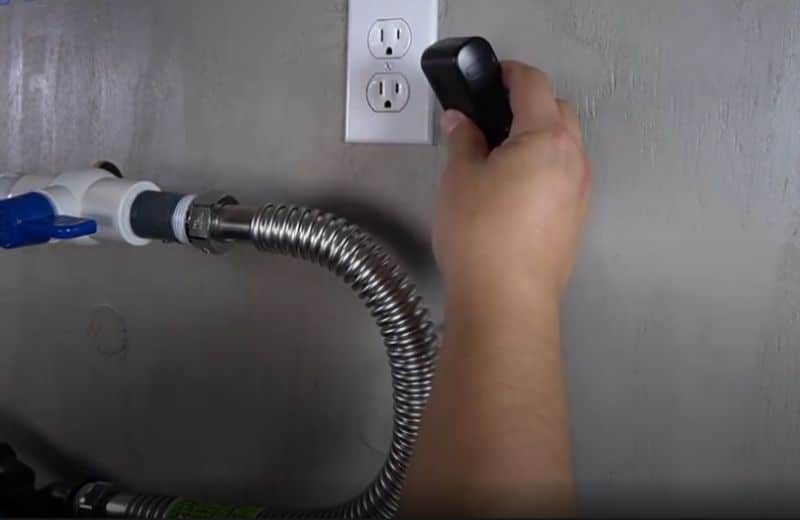
▶️ Step 3: Set the Clock Settings
All water softeners need to regenerate. As the water softener regeneration cycle length can take several hours, it’s convenient for this to take place overnight.
You need to set your water softener’s clock to the right time to make sure this can happen. For instance, if your clock dial reads 9AM but it’s actually 2PM, your water softener will end up regenerating 5 hours earlier than anticipated.
Most water softening systems have a knob that you can turn to adjust the current time. Some modern systems have a digital clock that you can set by pressing buttons or following touch-screen commands.
▶️ Step 4: Set the Hardness Setting
Next, input your water hardness into the water softener. If you don’t already know your water hardness, test your water with a water hardness test kit now.
The more accurate your hardness input, the more effectively the water softener can soften your water. The hardness of your water determines how much sodium is needed during the softening process. If the salt dose is too low, you won’t get properly soft water.
The majority of softeners allow you to input a water hardness between 0 and 99 grains per gallon (GPG).
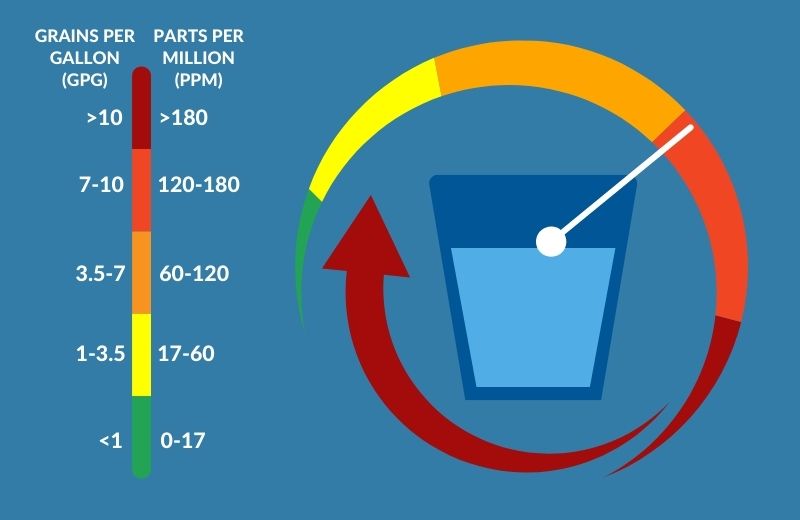
▶️ Step 5: Set the Salt Dosage Setting (If Applicable)
Now set the salt dose setting. This will program how much salty water enters the resin tank during the brine draw and brine fill stages of water softener regeneration. The harder your water, the bigger the salt dose required from the brine line.
If you’re unsure, follow the manufacturer’s instructions and use the recommended settings in the user manual based on the hardness of your water supply and your water usage.
Some softening systems are smart enough to calculate whether less or more salt is needed from the brine tank per regeneration cycle. In this case, you won’t need to input these settings yourself.
▶️ Step 6: Set the Regeneration Setting
Finally, set your water softener regeneration settings. A regen cycle involves flushing the resin beads to remove calcium and magnesium minerals, then adding sodium ions to the resin beads to replenish the used-up salt.
There are two common types of regeneration in most systems today:
- Metered regeneration: Regenerates based on water usage
- Timed regeneration: Regenerates at a certain time and day, regardless of water usage
Depending on your water softener’s regeneration process, you may need to set the regeneration cycle frequency, time, or length. Follow the manufacturer’s specifications in the user manual to make sure you correctly program the regeneration cycle settings.
📖 How to Program a Softening System With a Digital Control Head
To program a softening system with a digital control head, follow the steps listed above. All of your programming will be done directly into the control head itself.
Once you’ve plugged in and switched on your water softener, the control head should light up. From here, follow the on-screen instructions (or the user manual) to program each individual setting in your water softener.
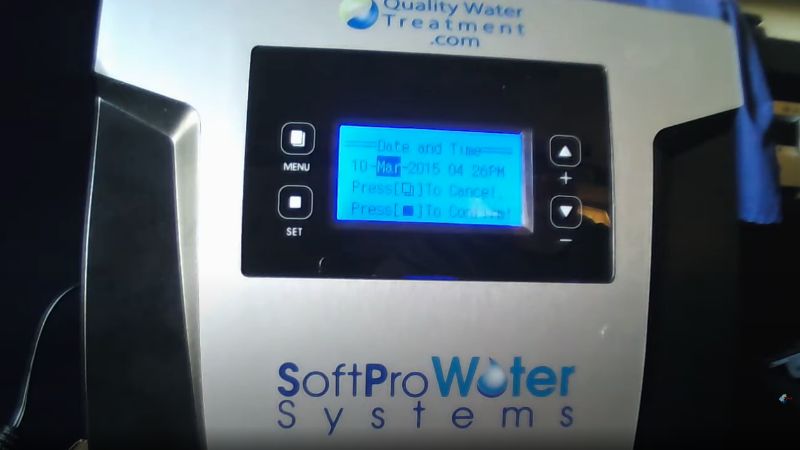
📟 How to Program a Softening System With Bluetooth Control
A water softener with Bluetooth control allows you to program the settings remotely. Most likely, the softener will have a digital control head, but Bluetooth programming allows you to input the settings for this control head on your phone.
To program water softener systems with Bluetooth control, switch on your phone’s Bluetooth and download the manufacturer’s Bluetooth app (information about this should be found in your user manual). Then, use the app to program the softener’s settings as you would on the control head.
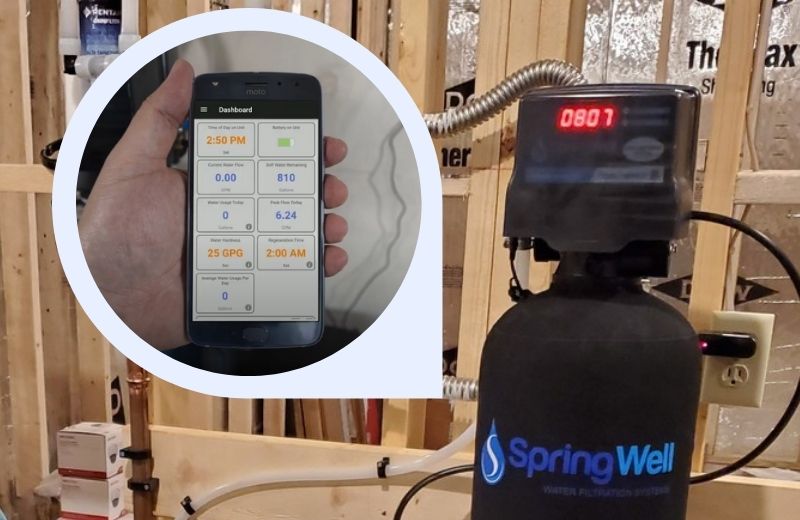
⏱ How to Program a Softening System With Clock Control
Most water softeners are now sold metered, which means they regenerate based on water use, rather than time. However, there are still plenty of clock control water softeners in people’s homes.
If your water softener has clock control, you can program the softener’s regeneration cycle time by moving the gear or dial on the top of your resin tank to your current time and your preferred regeneration time.
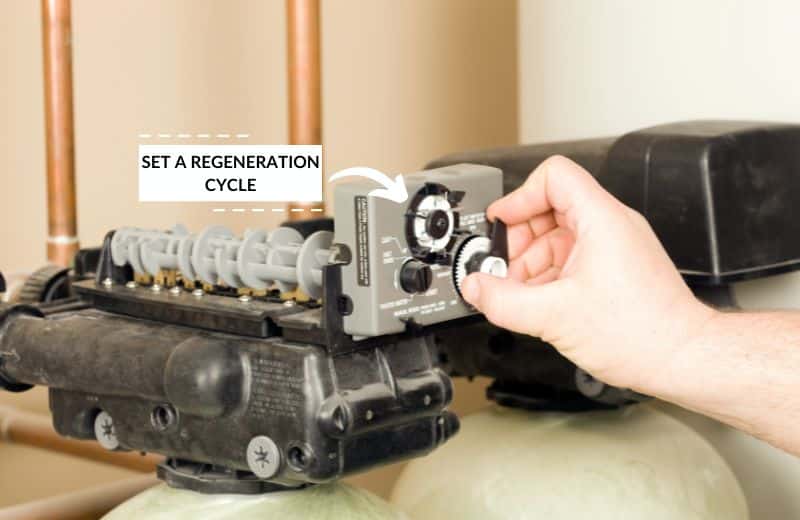
🧠 How to Program a Water Softening System: FAQs
What should my water softener hardness be set at?
Your softener hardness should be set at whatever hardness your water is. It’s essential to have the proper settings for hard water treatment. If your hardness is set too low or too high, you might not get the proper soft water output for your household needs.
Related Article: How to figure out what water softener model you have
How often should I set my water softener to regenerate?
Most people let their unit regenerate every three days to once a week. This typically depends on your hard water setting, the system capacity, and your water usage.
What happens if water softener is set too high?
If your hard water setting is too high, the softening system will regenerate too frequently, increasing operating costs and wasting salt and water.
Do softeners run constantly?
Yes, water softening systems are constantly in operation, delivering soft water to your water heater, faucets, showerheads, and other plumbing fixtures. However, softeners only regenerate every 3-7 days on average, so if you can hear constantly running water, you may have an internal problem that you need to troubleshoot.

Is it possible to hack into a water softener system with Bluetooth controls and manipulate the settings remotely? What security measures should be taken to prevent unauthorized access to the system?”,
“refusal
Good question! I have no idea. Let me know if you investigate and what you find out.
How do I program an older superior water softener? The model number is SW3MPBP. The original owner of the house left me no manuals for any of my appliances. I called Superior left a message to have them come out…no return answer it’s been a year! I tried going online to download the pdf manual? I couldn’t find one? For some reason it continues to go offline and goes blank! I happen to have a maintenance worker in the house and he looked at it and restarted it. Well it went offline again …power failure and it’s not regenerating. I was able to figure out how to put in the day and time the rest was programmed but it’s not showing the regeneration schedule like before? It only blinks the date and time number of days for regeneration hardness of water etc but it’s not doing the countdown to regeneration? If you know where I can find the manual that would be awesome so I can just do it myself!
Thanks
If you can’t find the manual online, all I can recommend is to continue to try to get in contact with the company. They should be able to provide it to you.
I have anums water softner angd i am not sure how to set the clock
Do you have the manual?
I recently bought a house that has an older water softener system. It has two resin tanks with two separate control heads, and I am not sure how to program them to work in tandem because the previous owner had them unplugged and was not using them. They already are plumbed together with all necessary valves, but it seems that only one of them is connected to the brine tank.
Hey Jim, thanks for reaching out. First thing is to confirm that it really is a twin tank water softener, and not a softener and another system like some type of filter. Are you on city water or well water? Did the previous own leave any documentation about the treatment system? Missing that, there might be indication on the tanks themselves as to what each is.
We are on Wellwater. Unfortunately, there was no documentation left about the system. Each tank has its own separate control head, and they are plumbed together. One tank is shorter than the other and that is the tank that is connected to the brine I can look as soon as I get a chance to see if there is anything on the tanks themselves. They do both seem to be resin tanks.
One might be an air injection oxidation system, used to treat iron, manganese and/ or hydrogen sulfide.
On another note, when was the last time the well water was tested by a certified lab?
We have a Morton water softener. The water does not seem to be soft, soap does not seem to make suds like soft water should. What should the softener be set on? Please advise, I can not seem to find the answer.
Hey Terri, have you tried the steps outlined in the product’s instruction manual? There should be specific step by step instructions for your unit. If you need help locating the manual, drop the product info here and I’d be happy to look it up for you.